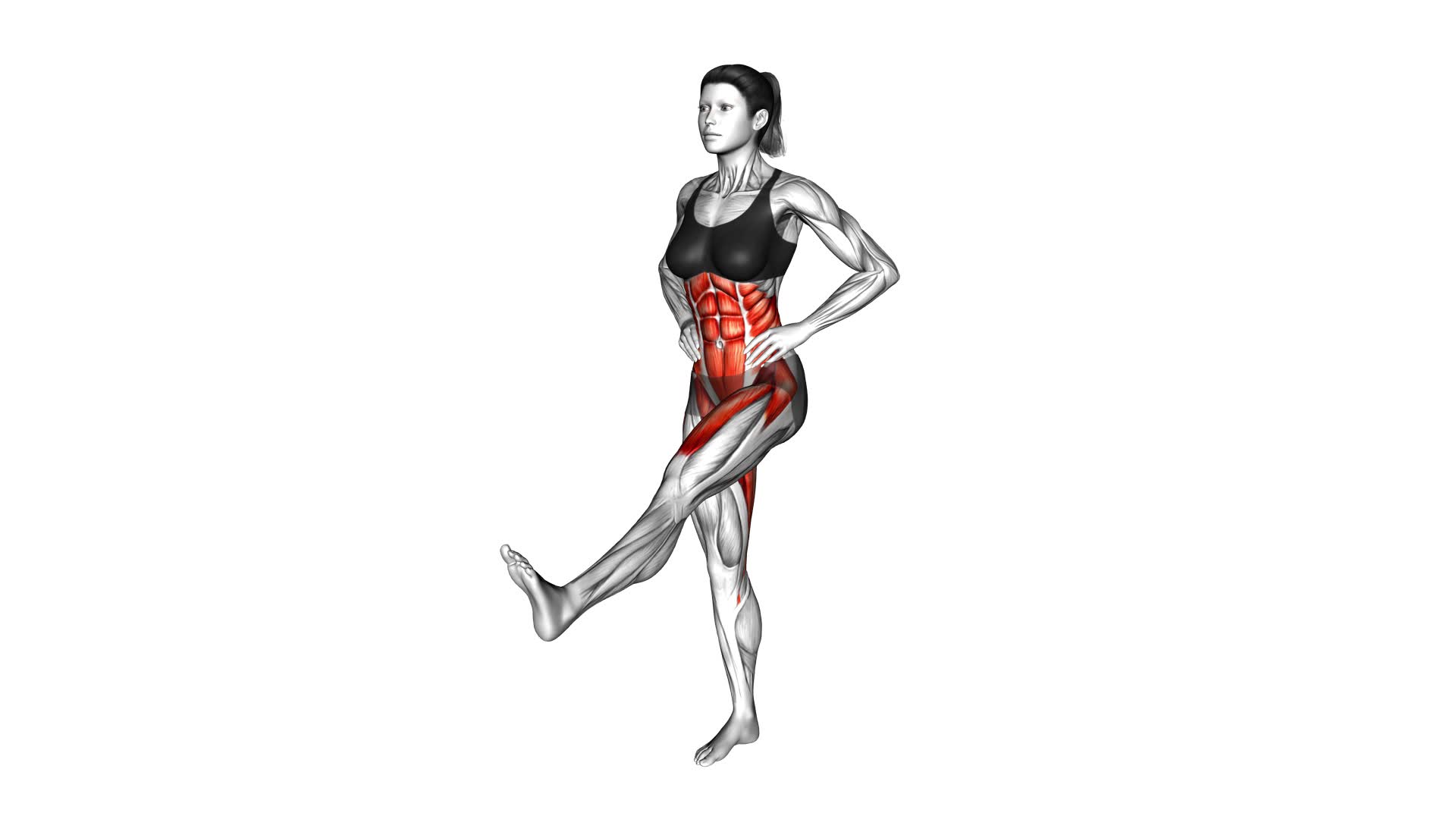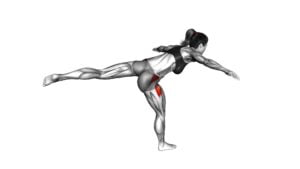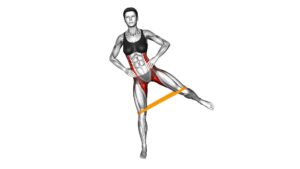Standing Balance Hip Flexion (female) – Video Exercise Guide & Tips

Are you looking to improve your balance and strengthen your hip flexors?
Watch This Exercise Video
In this video exercise guide, we'll show you the proper technique for standing balance hip flexion.
With variations to keep you challenged and tips for progressing, you can easily incorporate these exercises into your workout routine.
Whether you're a beginner or an experienced fitness enthusiast, this guide will help you achieve better stability and flexibility in your hips.
Let's get started!
Key Takeaways
- Standing Balance Hip Flexion exercises improve stability, flexibility, and coordination.
- Engaging core muscles and maintaining proper technique is crucial for effective execution of the exercise.
- Variations of Standing Balance Hip Flexion exercises can add variety and challenge to your workout routine.
- Incorporating unstable surfaces and progressing the difficulty level can enhance the benefits of the exercise.
Benefits of Standing Balance Hip Flexion Exercises
Experience the numerous benefits of standing balance hip flexion exercises. By incorporating these exercises into your workout routine, you can improve stability and increase flexibility. Standing balance hip flexion exercises target the muscles in your hips, including the hip flexors, glutes, and core muscles. These exercises require you to stand on one leg while lifting the other leg in front of you, engaging and strengthening the muscles responsible for stability and balance.
Improving stability is a crucial aspect of any fitness regimen. Whether you're an athlete looking to enhance your performance or simply someone wanting to prevent falls and injuries, standing balance hip flexion exercises can help. These exercises challenge your body's ability to maintain equilibrium, forcing your muscles to work together to keep you steady. Over time, this can lead to improved balance and coordination.
In addition to stability, standing balance hip flexion exercises also help to increase flexibility. As you lift your leg in front of you, you're stretching the hip flexors, which can become tight and shortened from prolonged sitting or inactivity. By regularly performing these exercises, you can lengthen and loosen these muscles, allowing for greater range of motion in your hips.
Incorporating standing balance hip flexion exercises into your fitness routine can provide you with a range of benefits, from improved stability to increased flexibility. Start incorporating these exercises into your workouts today to experience these positive effects for yourself.
Proper Technique for Standing Balance Hip Flexion
To perform the standing balance hip flexion exercise with proper technique, you should frequently engage your core muscles and maintain stability while lifting one leg in front of you. This exercise is an effective way to improve your hip flexibility and enhance your standing balance. It's essential to avoid some common mistakes that can hinder your progress.
One common mistake isn't engaging your core muscles throughout the exercise. Your core muscles provide stability and support, so it's crucial to activate them to maintain proper form.
Another mistake isn't maintaining a stable position while lifting your leg. It's important to keep your standing leg slightly bent and your weight evenly distributed to prevent wobbling or falling. Proper technique in standing balance hip flexion also involves lifting your leg with control and avoiding any jerky or sudden movements.
Variations of Standing Balance Hip Flexion Exercises
To add variety to your standing balance hip flexion exercises, you can incorporate different variations that challenge your stability and increase the intensity of the exercise. Here are three modifications and advanced hip flexion exercises to try:
- Single-leg standing balance hip flexion: Stand on one leg and raise the opposite knee towards your chest, while keeping your balance. This exercise not only targets your hip flexors but also improves your overall balance and stability.
- Resistance band standing balance hip flexion: Attach a resistance band to a sturdy anchor and loop it around your ankle. Stand on one leg and lift the opposite knee towards your chest against the resistance of the band. This variation adds an extra challenge by engaging your hip flexors while also working your glutes and outer hip muscles.
- Medicine ball standing balance hip flexion: Hold a medicine ball in your hands and stand on one leg. Lift the opposite knee towards your chest while simultaneously reaching the medicine ball towards your knee. This exercise not only targets your hip flexors but also engages your core and upper body.
Incorporating these standing balance hip flexion modifications and advanced exercises into your routine will help you strengthen your hip flexors, improve your balance, and take your workout to the next level.
Incorporating Standing Balance Hip Flexion Into Your Workout Routine
To incorporate standing balance hip flexion into your workout routine, start by adding these variations and advanced exercises that challenge your stability and engage your hip flexors.
Incorporating balance exercises into your routine not only helps improve your overall stability and coordination but also enhances the benefits of hip flexion exercises.
One way to incorporate standing balance hip flexion is by performing the exercise on an unstable surface, such as a balance board or BOSU ball. This adds an extra challenge to your stability and forces your hip flexors to work harder to maintain balance.
Another variation is to use resistance bands during the exercise. Attach one end of the band to a stable anchor point and the other end to your ankle. As you lift your leg, the resistance from the band adds an extra challenge to your hip flexors.
To further engage your hip flexors, try incorporating dynamic movements into your balance exercises. For example, you can perform standing leg swings or marching in place while maintaining your balance.
Incorporating standing balance hip flexion into your workout routine not only helps improve your stability and coordination but also strengthens your hip flexors. By adding variations and advanced exercises, you can challenge yourself and maximize the benefits of these exercises.
Tips for Progressing and Challenging Yourself in Standing Balance Hip Flexion Exercises
As you progress in your standing balance hip flexion exercises, you can challenge yourself by incorporating additional variations and advanced techniques. Here are some tips to help you modify and advance your standing balance hip flexion exercises:
- Increase the range of motion: Gradually work towards lifting your knee higher while maintaining your balance. Start by lifting your knee to a comfortable level and then aim to increase the height as you become more confident and stable.
- Add resistance: Hold onto a dumbbell or resistance band while performing the standing balance hip flexion exercise. This will increase the difficulty and engage your hip flexor muscles even more.
- Introduce instability: Incorporate a balance board or Bosu ball into your exercise routine. These unstable surfaces will challenge your balance and force your hip flexor muscles to work harder to maintain stability.
To ensure you're getting the most out of your standing balance hip flexion exercises, be aware of some common mistakes to avoid. These include leaning too far forward or backward, relying too much on your supporting leg, and not engaging your core muscles. By maintaining proper form and technique, you can maximize the effectiveness of these exercises and continue to progress in your fitness journey.
Frequently Asked Questions
What Are Some Common Mistakes to Avoid While Performing Standing Balance Hip Flexion Exercises?
When performing standing balance hip flexion exercises, it's important to be aware of common mistakes to avoid. Proper form is crucial to prevent injury and maximize the benefits of the exercise.
Some common mistakes include:
- Leaning forward or backward
- Not engaging your core muscles
- Lifting your leg too high or too quickly
How Can Standing Balance Hip Flexion Exercises Help Improve Overall Balance and Stability?
Standing balance hip flexion exercises can greatly improve your overall balance and stability. By strengthening the muscles in your hips and core, these exercises help you maintain an upright posture and prevent falls. This is especially important for seniors, as balance declines with age.
Additionally, hip flexion is crucial for daily activities such as walking, climbing stairs, and getting in and out of chairs. Regularly incorporating these exercises into your routine can enhance your functional abilities and quality of life.
Are There Any Modifications or Adaptations for Individuals With Limited Mobility or Injuries?
Modifications for limited mobility and injury adaptations can be made to standing balance hip flexion exercises. These adjustments allow individuals with restricted movement or injuries to still benefit from the exercise.
By modifying the range of motion or providing additional support, you can safely engage in this exercise while reducing the risk of further injury.
It's important to consult with a healthcare professional or a qualified trainer to determine the appropriate modifications for your specific needs.
Can Standing Balance Hip Flexion Exercises Be Beneficial for Athletes or Individuals Involved in Specific Sports?
Standing balance hip flexion exercises can be highly beneficial for athletes and individuals involved in specific sports. By incorporating these exercises into your training routine, you can improve your overall balance and stability, which are crucial for optimal athletic performance.
Additionally, standing balance hip flexion exercises help strengthen the muscles in your hips, reducing the risk of injuries such as strains or sprains.
Make sure to consult with a fitness professional to ensure proper form and technique for maximum benefits.
How Frequently Should Standing Balance Hip Flexion Exercises Be Incorporated Into a Workout Routine for Optimal Results?
To get optimal results, it's important to know how frequently to incorporate standing balance hip flexion exercises into your workout routine.
The frequency of these exercises will depend on your goals and fitness level. However, for most individuals, performing them 2-3 times a week should be sufficient.
These exercises can benefit older adults by improving balance, stability, and hip strength, which are important for maintaining independence and preventing falls.
Conclusion
Incorporating standing balance hip flexion exercises into your workout routine can be highly beneficial for improving your balance, stability, and overall lower body strength. By following proper technique and exploring variations of this exercise, you can challenge yourself and progress over time.
Remember to listen to your body and start with a level that suits your fitness level. With consistency and dedication, you can reap the benefits of this exercise and enhance your fitness journey.

Author
Years ago, the spark of my life’s passion ignited in my mind the moment I stepped into the local gym for the first time. The inaugural bead of perspiration, the initial endeavor, the very first surge of endorphins, and a sense of pride that washed over me post-workout marked the beginning of my deep-seated interest in strength sports, fitness, and sports nutrition. This very curiosity blossomed rapidly into a profound fascination, propelling me to earn a Master’s degree in Physical Education from the Academy of Physical Education in Krakow, followed by a Sports Manager diploma from the Jagiellonian University. My journey of growth led me to gain more specialized qualifications, such as being a certified personal trainer with a focus on sports dietetics, a lifeguard, and an instructor for wellness and corrective gymnastics. Theoretical knowledge paired seamlessly with practical experience, reinforcing my belief that the transformation of individuals under my guidance was also a reflection of my personal growth. This belief holds true even today. Each day, I strive to push the boundaries and explore new realms. These realms gently elevate me to greater heights. The unique combination of passion for my field and the continuous quest for growth fuels my drive to break new ground.



